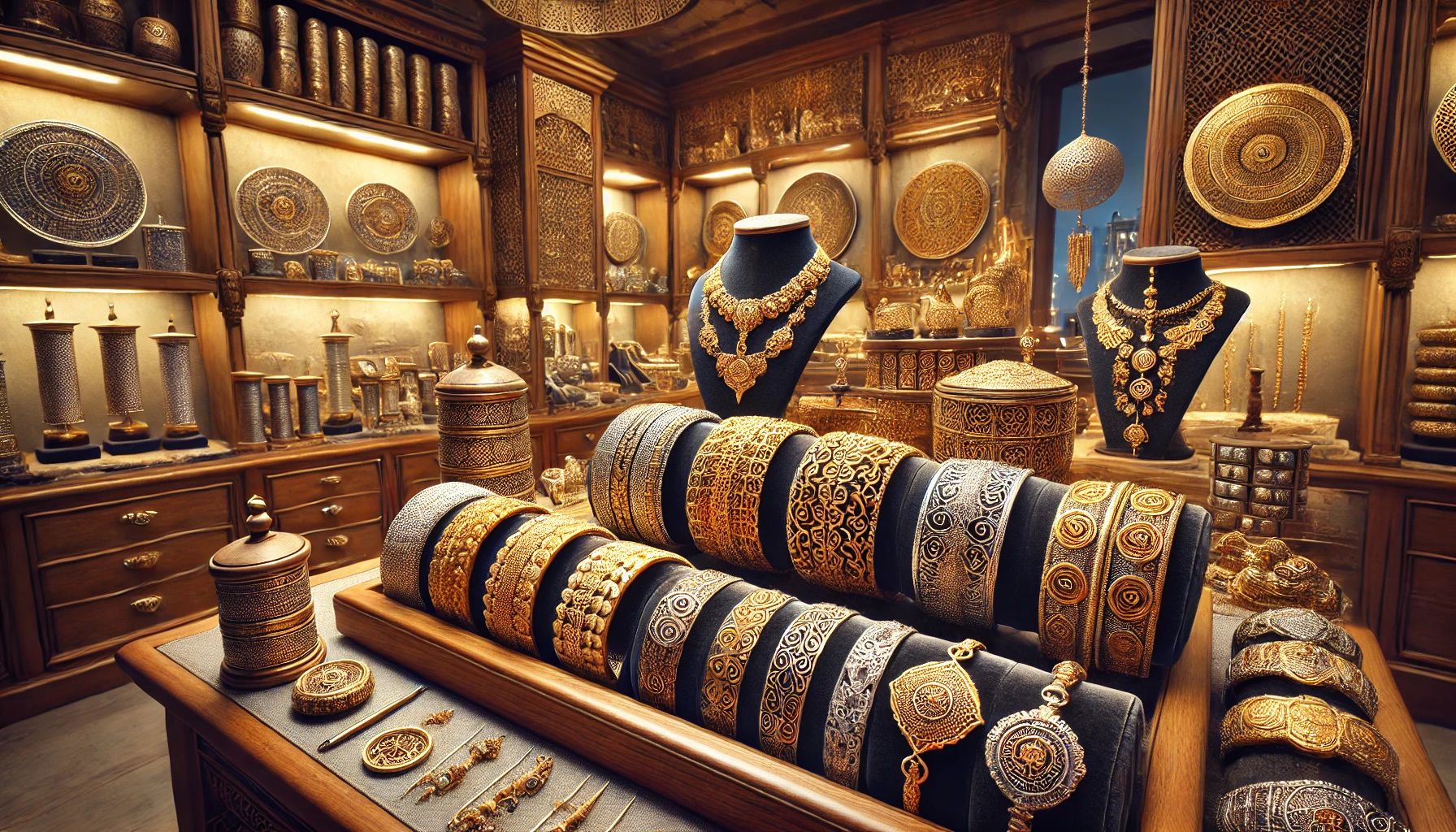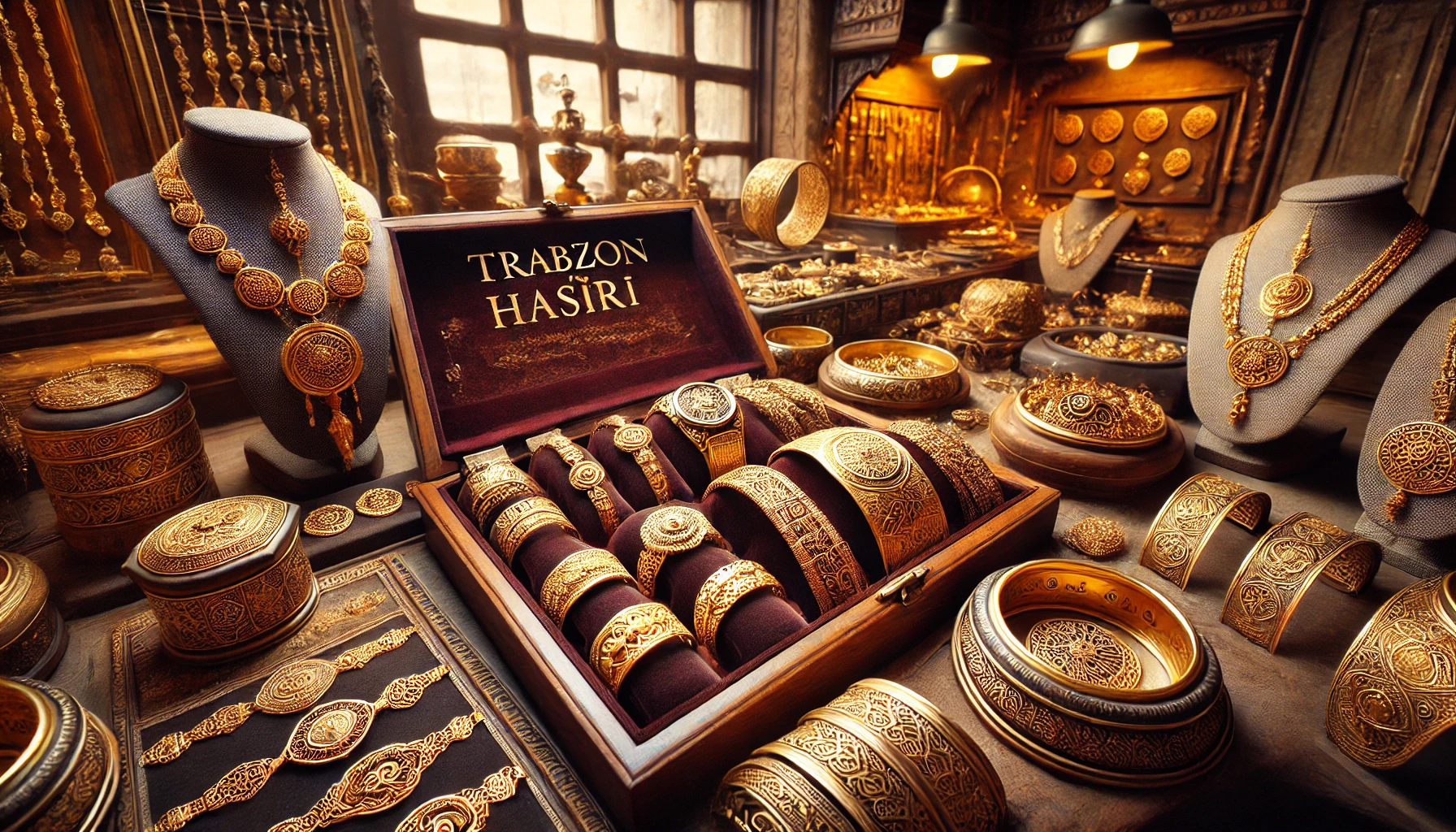Trabzon filigree and wickerwork is a traditional handicraft unique to Trabzon province in Türkiye, referring to the production of ornaments, jewelry, and valuables obtained by finely weaving gold and silver wires. Applied for on September 22, 2006, and registered as a designation of origin, this product group was registered as a geographical indication by the Trabzon Jewelers and Watchmakers Chamber.

Trabzon Filigree and Wickerwork (Generated with Artificial Intelligence)
Scope
The geographical indication, under the name "Trabzon Filigree and Wickerwork", covers the following products handcrafted from 22 carat (916 millesimal fineness) gold and 900 fineness silver:
- Gold products: Bracelet, necklace (choker), earring, ring
- Silver products: Bracelet, necklace, choker, earring, ring
- Silver decorative items: Napkin holder, tray, coffee and tea saucer, candlestick, sugar bowl, and similar objects
These products can also be produced as sets, known as "Trabzon gold woven ring" and "Trabzon silver woven ring".
Material Properties
The fineness and chemical properties of the metals used in production are as follows:
- Gold: 916 millesimal fineness, 22 carat. This ratio means a mixture of 22 parts gold with 2 parts copper. Optionally, it can be alloyed with silver. Pure gold (24 carat) is 1000 millesimal fineness. Gold's density is 19.3 g/cm³, melting point is 1063 °C, boiling point is 2966 °C.
- Silver: 900 fineness silver is used.
Gold has high electrical and thermal conductivity and does not tarnish at high temperatures. It only reacts with "aqua regia" (HNO₃ + HCl).
Production Method
The production of Trabzon gold and silver wickerwork is fundamentally a handicraft process based on the filigree technique. The basic materials used in production are; 31–32 micron thick gold or silver wire, tongs (stretching and compressing tool), and a steel sewing needle. Generally, 22 carat (916 millesimal fineness) gold or 900 fineness silver is used in the products. The metal, converted into wire, is prepared in 80–100 gram coils depending on the type of product. These wires are cut to a length that the weaver can work with; typically 100 to 125 cm is preferred.
Small triangular loops are formed according to the number of rows (or strands) of the wickerwork to be woven. These loops are obtained by wrapping them around a rolled paper or a matchstick, measuring 1–3 mm. The loops form the basis of the weaving process. There is a fixed relationship between the number of rows and the number of loops: for example, 18 loops are used for 19 rows, and 4 loops for 5 rows.
Inside each loop, with the help of tongs, small triangular peaks are formed six times, by stretching and compressing them alternately in a straight and reversed manner. During weaving, the filled peaks are completed from one direction, then the empty ones from the opposite direction are completed to create a pattern in all loops. This process is applied in six repetitions. The technique used at this stage is to ensure the balanced slope of the wicker weave. During the weaving process, a 32-micron wire is passed through and within the created triangular peaks. The structure of the weave is strengthened by compressing and stretching with tongs. In tightly woven structures, wire passage may become difficult over time. In this case, a regular steel sewing needle is used to open holes at the tips of the triangular peaks, allowing the wire to pass through.
The weaving process continues in an alternating straight and reversed pattern until the desired length is achieved. This technique ensures a similar appearance on both sides of the woven surface. When weaving is complete, the cut wire ends are gathered on a single side of the weave. This surface is designated as the part that will come into contact with the body during use of the product, and is used as the area where the clasp/fastener will be attached in the final processes.
Usage and Marking
The name "Trabzon Filigree and Wickerwork" is used on the products. The usage form is labeling. For marking the products, a stamp consisting of the letters TTH (Trabzon Filigree and Wickerwork) is used. This stamp is oval-shaped, 6 mm wide and 9 mm long. Even on products without the TTH stamp, labels must include the manufacturer's name, the type and fineness of the material, and information indicating that the product was produced using the Trabzon technique.
Geographical Boundary and Origin
The product is geographically limited to Trabzon province. The development of filigree and wickerwork craftsmanship in Trabzon is based on a historical process. After Trabzon's incorporation into Ottoman territory in 1461, the trade of silver extracted from Gümüşhane through Trabzon port led to the development of this craft in Trabzon.
Silver and gold craftsmanship developed as a skill among women living in Trabzon's central districts and villages; traditional mastery has been passed down from generation to generation. The continuity of this cultural transfer and the formation of region-specific patterns have contributed to Trabzon filigree and wickerwork's distinctive cultural identity.
Distinguishing Features
Trabzon Wickerwork is produced entirely by hand weaving from wire. Its prominent structural features include:
- Its woven surface's tightness prevents water poured onto it from seeping underneath.
- The patterns and weaving system are symmetrically developed using region-specific techniques.
- Each product is unique due to the mastery and time required by the weaving techniques used.
Inspection Mechanism
Products produced under the geographical indication are inspected by an inspection board established under the coordination of the Trabzon Jewelers and Watchmakers Chamber. The inspection board includes representatives from the following institutions:
- Ortahisar District Governorship Public Education Center Directorate
- Ortahisar Vocational Training Center Directorate
- Experts from the Trabzon Jewelers and Watchmakers Chamber
The scope of inspection includes:
- Conformity to the production method
- Presence and conformity of the TTH stamp
- Fineness determination (by melting or cutting if necessary)
- Detection of whether the product is second-hand and carrying out appropriate procedures
- Proper use of the designation of origin emblem
Inspections are carried out regularly at least once a year. Inspections may be repeated in necessary cases and upon complaint. Services may be obtained from public institutions or private sector experts. The registering institution is responsible for conducting legal processes.

Trabzon Filigree and Wickerwork (Generated with Artificial Intelligence)


